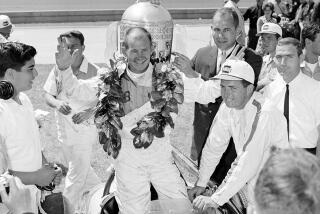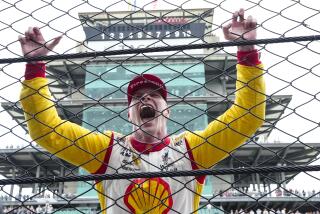Johncock, 48, Says Fun Is Gone, Ends a 30-Year Career
INDIANAPOLIS â Ask any longtime race driver when he plans to retire, and heâll invariably reply, âOne day, Iâll wake up and Iâll realize itâs not fun anymore, and Iâll quit right on the spot.â
Friday, the day before he was to qualify for what would have been his 21st Indianapolis 500-mile race, Gordon Johncock woke up with that realization.
Johncock, 48, a two-time 500 winner, had lapped the Speedway at nearly 211 m.p.h.--faster than the official track record--earlier in the week, but Friday, he walked into the garage used by Pat Patrickâs racing team and announced that his 30-year career was over.
âEvery morning this week, I woke up and asked myself, âWhy am I doing this?â And this morning, I decided Iâd had enough,â Johncock said at a tearful press conference.
âI made my decision this morning, not last night, not yesterday, not last Monday. I wasnât even sure when I drove off this morning for the track. Every time I stopped for a traffic light, my thoughts changed. At one light, Iâd say to myself, âMaybe I shouldnât do it.â Then, at the next light, I would think, âYouâve got to. Itâs no fun anymore.â
âThe only regret I have today is that I should have done it earlier, as far as Pat and the crew is concerned. It was probably unfair on my part this way. Iâm sorry.â
Patrick, a Michigan oilman who has been Johncockâs car owner since 1973, was shocked.
âThe crew just about had the car ready for Gordie when he walked in and said he was quitting,â Patrick said. âAt the time, I thought he was kidding. Heâs always joking around like a little kid. But then I saw his face and I knew he was serious.
âI was shocked, but Iâm happy for him. As long as he wanted to drive, I would have a car ready for him, but if there was ever the slightest hesitancy about driving, I wouldnât want him in a race car.â
Don Whittington, who has not driven in an Indy car race since 1983, took over the No. 20 March-Cosworth later in the day and got it up to 212.715 m.p.h. Whittington, whose brother, Bill, is driving for the Arciero team, is expected to qualify No. 20 today and will drive the car in the oval-track races in the PPG Indy car series this season.
Johncock said he had no plans to stay in racing in any capacity.
âI started out in life as a farmboy in Michigan and Iâve never really changed,â he said. âI expect to spend the rest of life on my ranch in Arizona. Thatâs what I really enjoy.â
The ranch is a 14,000-acre spread near Fort Thomas, about 100 miles northeast of Phoenix.
âIâve been living out of a suitcase, packing and unpacking, for 30 years, and it just about killed me to leave the ranch last week and come here,â Johncock said. âRacing has changed in the past few years, and the fun has gone out of it for me.â
Johncock said that the decision was not caused by Patrickâs hiring of Bruno Giacomelli, a Formula One driver, to drive Johncockâs car in CART road races, nor was it influenced by his numerous crashes last year. He broke his ankle twice, and after crashing at the Michigan 500, the 5-7 Johncock spent the rest of the season on crutches.
âIf I had any fear of being injured again, I wouldnât have come here and run 210,â he said. âIt was not a factor at all. I would have liked to have driven the road races because the cars are working a lot better this year than the last couple of years, but thatâs all water over the dam now.â
Johncock also said that accelerating speeds had not contributed to his decision.
âI donât think itâs necessary to run that fast to put on a good race, but I feel the cars are much safer than they have ever been,â he said. âLike I said, if I felt afraid to run that fast, Iâd have quit long ago.â
When Johncock first came to the Speedway in 1965, he qualified a front-engine roadster at 155.012 m.p.h. and finished fifth.
âI think I drove just as hard to get 155 then as I did to run 210,â he said. âItâs what your car is prepared to run that counts, and these cars today are prepared to run 210. If you want to run quick, you have to run hard, whatever youâre driving.â
Johncockâs retirement surprised his fellow drivers as much as it did his owner and crew.
âIâm certainly surprised,â 1969 winner Mario Andretti said. âGordie and I broke into USAC together and were rookies here together. He and I had a lot of battles. I must say, many of them were intense and really a lot of fun.
âIn a way, itâs hard to see him going, but Iâm glad to see his career end this way. Heâs walking away with his health. Believe me, it takes a lot of courage to do what he did. I admire that.â
Three-time winner Johnny Rutherford echoed Andrettiâs feelings.
âSurprised?â parried Rutherford, who has also driven in 20 500s. âShocked might be a better word. If thatâs what he wants, then Iâm happy for him. I mean truly happy. I like to see a guy go out standing tall after a great career.â
Only four-time winner A. J. Foyt had different thoughts.
âEverybody has days when they wake up and think theyâve had enough,â Foyt snapped. âThat happens in any kind of business. Some days are wonderful, some are terrible. Itâs the same in racing. Naw, I wasnât surprised. Nothinâ surprises me anymore.â
Johncockâs two Indianapolis 500 wins, in 1973 and 1982, are among the most memorable in the raceâs 68 years, but for widely differing reasons.
Johncock won in â73 because he happened to be a minute in front of Billy Vukovich when the race was stopped by rain after 133 laps.
It was not a race to remember. Johncockâs STP teammate, Swede Savage, crashed and sustained injuries that led to his death a month later. An STP crewman, Armando Teran, was racing down pit row toward the accident scene when he his hit and killed instantly by a safety vehicle.
Earlier in the month, Art Pollard had been killed in a practice accident, and during an abortive race start, Salt Walther crashed, and his car sent flaming fuel into the stands. Nine spectators were hospitalized.
âI never felt like I won anything,â Johncock said later. âI never took the checkered flag (the race was stopped by rain and never resumed), I never sat in victory circle and I never had a victory banquet (rain had delayed the race three days, and the banquet was canceled) and my check ended up in bankruptcy court.â
The bankruptcy was caused when Johncockâs logging business failed in Michigan.
For the next eight years, Johncock had one of the best records of any driver at Indianapolis, but one pesky problem after another prevented him from winning. In eight races from 1974 to 1981 he finished 6 times in the top 10.
He was leading in 1977 with 16 laps to go when he broke a crankshaft and slowed to a stop at the end of the front straightaway. As Foyt came by to take over the lead, Johncock waved at him and then jumped into a small lake inside the first turn to cool off.
In 1981, he led 52 laps and was racing with Andretti and Bobby Unser for the lead when a fuel pump quit six laps from the finish.
âI get awful discouraged sometimes,â Johncock said when he arrived here for the 1982 race. âWhenever Iâm out there and things are going good, I start thinking, âWhatâs going to happen now?â â
In 1982, he and Rick Mears put on the closest race in 500 history, ending with Johncock barely holding on to win by .16 of a second. For the last few laps, the two drove almost as one car around the 2 1/2-mile track.
That time, Johncock got the checkered flag, the swig of milk in victory circle and victory banquet, where he received a check for $290,609--which he got to keep.
Last year, even though a wreck on the front straightaway on Lap 104 ended his hopes of winning a third 500, he had the fastest racing lap in Indy history at 204.815.
Only Foyt and Al Unser have driven more miles at Indy than Johncock. He logged 7,037 miles and has led for 339 laps in 20 races. He is fifth in Indy 500 earnings with $1,157,293.
Friday, though, on a warm and sunny Indiana day in May, it wasnât fun anymore for Gordon Johncock.
More to Read
Go beyond the scoreboard
Get the latest on L.A.'s teams in the daily Sports Report newsletter.
You may occasionally receive promotional content from the Los Angeles Times.










